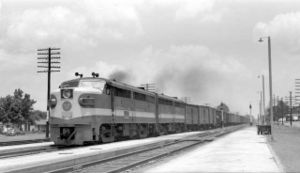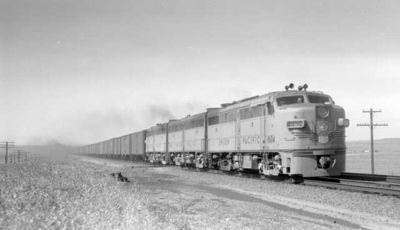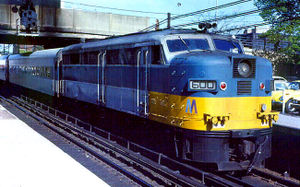ALCO FA
2007 Schools Wikipedia Selection. Related subjects: Railway transport
 GM&O #742, an ALCO FA-1, leads an eastbound freight train through Wikcliffe, KY, in June 1951. |
|
| Power type | Diesel-electric |
|---|---|
| Builder | American Locomotive Company (ALCO) |
| Model | FA |
| Build date | January 1946 — May 1959 |
| Total production | 1,354 |
| AAR wheel arr. | B-B |
| Gauge | 4 ft 8½ in (1435 mm) |
| Length | 53 ft 1 in (16.2 m) |
| Total weight | 243,000 lb (110,000 kg) 255,000 lb (116,000 kg) (FPA-4/FPB-4) |
| Fuel capacity | 1,200 gal (4,542 L) |
| Prime mover | ALCO 244 ALCO 251B (FPA-4/FPB-4) |
| Engine type | 4-stroke diesel |
| Aspiration | Turbocharger |
| Displacement | 8,256 in³ (135.2 L) |
| Cylinders | V12 |
| Cylinder size | 9 in × 10.5 in (229 mm × 267 mm) |
| Transmission | DC generator, DC traction motors |
| Top speed | 65 mph (105 km/h) |
| Power output | 1,500 hp (1,119 kW) — early FA-1/FB-1 1,600 hp (1,194 kW) — later FA-1/FB-1, FA-2/FB-2, FPA-2/FPB-2 1,800 hp (1,343 kW) — FPA-4/FPB-4 |
| Tractive effort | 60,875 lbf (271 kN) 63,750 lbf (284 kN) (FPA-4/FPB-4) |
| Locomotive brakes | Dynamic, straight air |
| Train brakes | Air |
| Locale | North America |
The ALCO FA was a family of B-B diesel locomotives designed to haul freight trains. The locomotives were built in Schenectady, New York, by the American Locomotive Company (ALCO) between January 1946 and May 1959. They were of a cab unit design, and both cab-equipped lead ( A unit) FA and cabless booster ( B unit) FB models were built. A dual passenger-freight version, the FPA/FPB, was also offered. It was equipped with a steam generator for heating passenger cars.
Externally, the FA and FB models looked very similar to the ALCO PA models produced in the same period. They shared many of the same characteristics both aesthetically and mechanically. It was the locomotive's mechanical qualities and newer locomotive models from both General Motors Electro-Motive Division (EMD) and General Electric (GE) that ultimately led to the retirement of the locomotive model from revenue service. Several examples of FAs and FBs have been preserved in railroad museums, a few of them in operational states on such lines as the Napa Valley Wine Train.
Models overview
Three different models were offered. The FA-1/FB-1, which featured a 1,500 hp (1,119 kW) rating, was built from January 1946 to October 1950 with a 1,600 hp version produced between March and August 1950 (many early models were subsequently upgraded to 1,600 hp). The 1,600 hp (1,194 kW) FA-2/FB-2 (along with the FPA-2/FPB-2 variants) was built between October 1950 and June 1956. The FPA-4/FPB-4 was built between October 1958 and May 1959 by ALCO's Canadian subsidiary, Montreal Locomotive Works (MLW).
Externally, the FA-1/FB-1 could be distinguished from the FA-2/FB-2 (FPA-1/FPB-2) by the position of the radiator shutters. The FPA-4/FPB-4 were visually different due to the additional radiator space that was positioned below the shutters. These Canadian variants were intended and used for high-speed passenger service, and remained in use into the 1990s on VIA Rail Canada.
The FA had the same distinctive styling as its larger cousin, the ALCO PA, with a long, straight nose tipped by a headlight in a square, slitted grille, raked windshields, and trim pieces behind the cab windows that lengthened and sleekened the lines. As with the PA, the overall design owed much to the Fairbanks-Morse Erie-built design, which had been constructed by ALCO's sales partner General Electric (GE) at their Erie, Pennsylvania, plant. GE's industrial designer Ray Patten styled the FA and FB, and many believe it likely that he took drawings of the Erie-built as a starting point, lengthening and squaring the nose and giving it a more aggressive look. The majority of FA components were compatible with the PA.
As with the PA, the model 244 diesel prime mover proved to be the undoing of the PA, and the locomotives failed to capture a marketplace dominated by General Motors Electro-Motive Division (EMD). The later 251-series engine, a vastly improved prime mover, was not available in time for ALCO to recover the loss of reputation caused by the unreliability of the 244. By the time the ALCO 251 engine was accepted into widespread use, General Electric had launched their entries into the diesel-electric locomotive market. General Electric eventually supplanted ALCO as a manufacturer of locomotives, leading to ALCO's demise in 1969.
Original production
Almost 800 FA units were built by ALCO and MLW, with just over 15% of them sold to New York Central Railroad, and another 5% each to Union Pacific Railroad, Gulf, Mobile and Ohio Railroad and Missouri Pacific Railroad. About half as many FB units were produced and sold in similar ratios.
| Units produced by ALCO and the Montreal Locomotive Works (1946–1956) | |||
|---|---|---|---|
| class="navbox collapsible autocollapse" | |||
| FA-1 units (cabs) | |||
| class="toccolours" | Railroad | Quantity | Road numbers |
| Canadian National Railway |
|
9400–9407 | |
| Canadian Pacific Railway |
|
4000–4027 | |
| Central of Brazil |
|
3201–3212 | |
| Chicago, Rock Island and Pacific Railroad |
|
145–160 | |
| Erie Railroad |
|
725A,D–735A,D | |
| Great Northern Railway |
|
276A, B, 319A, c, 449A, D, 442A, D | |
| Green Bay and Western Railroad |
|
501, 502, 503 (1st), 503 (2nd), 507 | |
| Gulf, Mobile and Ohio Railroad |
|
700–754 | |
| Lehigh and New England Railroad |
|
701–710 | |
| Lehigh Valley Railroad |
|
530–548 (even numbers only) | |
| Minneapolis, St. Paul and Sault Ste. Marie Railway |
|
205A, B–211A, B | |
| Missouri-Kansas-Texas Railroad |
|
326A, C–334A, C | |
| Missouri Pacific Railroad |
|
301–330 | |
| New York Central Railroad |
|
1000–1043 | |
| New York, New Haven and Hartford Railroad |
|
0400–0429 | |
| Pennsylvania Railroad |
|
9600–9607 | |
| Reading Railroad |
|
300A–305A | |
| St. Louis - San Francisco Railway |
|
5200–5231 | |
| S.C.O.P. (Mexico) |
|
23031–23034, 23039 | |
| Seaboard Air Line Railroad |
|
4200–4202 | |
| Spokane, Portland and Seattle Railway |
|
850A-1, -2-854A-1, -2, 856A-1, -2-860A-1, -2, 866A-1, -2 | |
| Tennessee Central Railway |
|
801–805 | |
| Union Pacific Railroad |
|
1500A–1523A, 1542A, 1543A, 1626–1643 | |
| Wabash Railroad |
|
1200, 1200A–1204, 1204A | |
| Wisconsin Central Railroad |
|
2220A, B–2223A, B |
|}
| FA-2 units (cabs) | |||
|---|---|---|---|
| class="toccolours" | Railroad | Quantity | Road numbers |
| American Locomotive Company (demonstrator units) |
|
1600A, 1600D, 1602A, 1602D | |
| Ann Arbor Railroad |
|
50, 50A–56, 56A | |
| Baltimore and Ohio Railroad |
|
801, 801A–837, 837A (odd numbers only) | |
| Canadian National Railway |
|
9408–9456 (even numbers only) | |
| Canadian Pacific Railway |
|
4042–4051, 4084–4093 | |
| Consolidated Railway of Cuba |
|
1600–1605, 1650–1655 | |
| Erie Railroad |
|
736A, D–739A, D | |
| Ferrocarriles Nacionales de Mexico |
|
6507A–6522A, 6519A (2nd), 6534A | |
| Great Northern Railway |
|
277A, 277B | |
| Louisville and Nashville Railroad |
|
300–320, 350–369, 383, 384 | |
| Lehigh Valley Railroad |
|
580–594 (even numbers only) | |
| Missouri-Kansas-Texas Railroad |
|
331A (2nd) | |
| Missouri Pacific Railroad |
|
331–386 | |
| New York Central Railroad |
|
1044–1123 | |
| Pennsylvania Railroad |
|
9608A–9631A | |
| S.C.O.P. (Mexico) |
|
7121-8–7121-13 | |
| Spokane, Portland and Seattle Railway |
|
868A-1, -2 | |
| Western Maryland Railway |
|
301, 302 |
|}
| FB-1 units (cabless boosters) | |||
|---|---|---|---|
| class="toccolours" | Railroad | Quantity | Road numbers |
| Canadian Pacific Railway |
|
4400–4423 | |
| Chicago, Rock Island and Pacific Railroad |
|
145B–152B | |
| Erie Railroad |
|
725B, C–735B, C | |
| Great Northern Railway |
|
310B, 440B, C, 442B, C | |
| Gulf, Mobile and Ohio Railroad |
|
B1–B33 | |
| Lehigh and New England Railroad |
|
751–753 | |
| Lehigh Valley Railroad |
|
531–549 (odd numbers only) | |
| Missouri Pacific Railroad |
|
301B–310B, 321B–325B | |
| New York Central Railroad |
|
2300–2322 | |
| New York, New Haven and Hartford Railroad |
|
0450–0464 | |
| Pennsylvania Railroad |
|
9600B–9607B | |
| Reading Railroad |
|
300B–305B | |
| St. Louis - San Francisco Railway |
|
5300–5315 | |
| Seaboard Air Line Railroad |
|
4300–4302 | |
| Spokane, Portland and Seattle Railway |
|
856B-1, -2–860B-1, -2(even numbers only), 866B-1, -2 | |
| Tennessee Central Railway |
|
801B | |
| Union Pacific Railroad |
|
1524B–1541B, 1618B, C–1642B, C (even numbers only) | |
| Wabash Railroad |
|
1200B–1204B |
|}
| FB-2 units (cabless boosters) | |||
|---|---|---|---|
| class="toccolours" | Railroad | Quantity | Road numbers |
| American Locomotive Company (demonstrator units) |
|
1600B, 1600C, 1602B, 1602C | |
| Baltimore and Ohio Railroad |
|
811x–817x (odd numbers only), 817ax, 819x–837x (odd numbers only), 837ax |
|
| Canadian National Railway |
|
9409–9437 (odd numbers only) | |
| Canadian Pacific Railway |
|
4465–4470 | |
| Erie Railroad |
|
736B, C–739B, C | |
| Ferrocarriles Nacionales de Mexico |
|
6507B–6527B, 6519B (2nd), 6534B | |
| Gulf, Mobile and Ohio Railroad |
|
834–837 | |
| Louisville and Nashville Railroad |
|
202–211, 330, 331 | |
| Lehigh Valley Railroad |
|
581–587 (odd numbers only) | |
| Missouri Pacific Railroad |
|
331B–335B, 345B–356B, 370B–386B | |
| New York, New Haven and Hartford Railroad |
|
465–469 | |
| New York Central Railroad |
|
3323–3372 | |
| Pennsylvania Railroad |
|
9608B–9630B | |
| Spokane, Portland and Seattle Railway |
|
868B-1, -2 |
|} |}
MLW built 125 of the various FP models with the largest quantity, 46% of the total production, sold to Canadian National Railway.
| Units produced by the Montreal Locomotive Works (1950–1959) | |||
|---|---|---|---|
| class="navbox collapsible autocollapse" | |||
| FPA-2 units (cabs) | |||
| class="toccolours" | Railroad | Quantity | Road numbers |
| Canadian National Railway |
|
6706–6711 | |
| Canadian Pacific Railway |
|
4082, 4083, 4094–4098 | |
| Ferrocarriles Nacionales de Mexico |
|
6500, 6501, 6502A–6506A, 6523A–6533A | |
| Ferrocaril del Pacifico |
|
901–904 | |
| Missouri Pacific Railroad |
|
361–390 |
|}
| FPB-2 units (cabless boosters) | |||
|---|---|---|---|
| class="toccolours" | Railroad | Quantity | Road numbers |
| Canadian National Railway |
|
6806–6811 | |
| Canadian Pacific Railway |
|
4463, 4464 | |
| Ferrocarriles Nacionales de Mexico |
|
6502B–6506B, 6528B–6533B | |
| Missouri Pacific Railroad |
|
387B–392B |
|}
| FPA-4 / FPB-4 units (cab units & cabless boosters) | |||
|---|---|---|---|
| class="toccolours" | Railroad | Quantity | Road numbers |
| Canadian National Railway (FPA-4) |
|
6760–6793 | |
| Canadian National Railway (FPB-4) |
|
6860–6871 |
|} |}
Surviving examples
Some 20 units of various designations exist today in a preserved state, all of which are owned by railway museums or historical societies. Several excursion railways, including the Grand Canyon Railway and Napa Valley Wine Train, own operating examples which are in regular service.
ALCO "World Locomotive"
ALCO's "World Locomotive" (introduced in 1953) is an 1,800 hp "cousin" to MLW's FPA-4 passenger locomotive. As with the FPA-4, these units ride atop six-wheel trucks and utilize the ALCO model 251B diesel engine as the prime mover. The only locale within the Americas where ALCO-built cab units, such as America Latina Logistica (ALL) #8414, still see daily usage in freight duty is Argentina.

